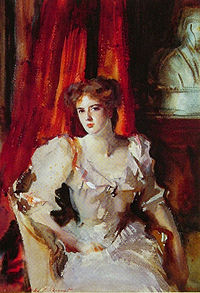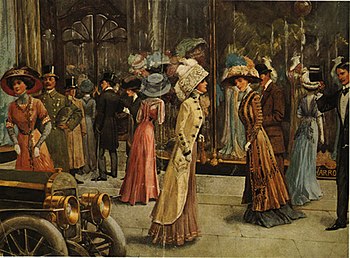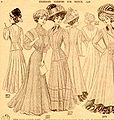1900s in fashion
From Wikipedia, the free encyclopedia
Fashion in the period 1900-1909 in European and European-influenced countries continued the long elegant lines of the 1890s. Tall, stiff collars characterize the period, as do women's broad hats and full "Gibson girl" hairstyles. A new, columnar silhouette introduced by the couturiers of Paris late in the decade signaled the approaching abandonment of the corset as an indispensable garment of fashionable women.
Contents[hide] |
[edit] Mrs. Ramsey's fashions
[edit] Overview


With the decline of the bustle, sleeves began to increase in size and the 1830s silhouette of an hourglass shape became popular again. The fashionable silhouette in the early 1900s was that of a mature woman, with full low bust and curvy hips. The "health corset" of this period removed pressure from the abdomen and created an S-curve silhouette.[1]
In 1897, the silhouette slimmed and elongated by a considerable amount. Blouses and dresses were full in front and puffed into a "pigeon breast" or monobosom shape of the early 20th century that looked over the narrow waist, which sloped from back to front and was often accented with a sash or belt. Necklines were supported by very high boned collars. [2]
Skirts brushed the floor, often with a train, even for day dresses, in mid-decade.
Around 1908, the fashion houses of Paris began to show a new silhouette, with a thicker waist, flatter bust, and narrower hips. By the end of the decade the most fashionable skirts cleared the floor and approached the ankle. The overall silhouette narrowed and straightened, beginning a trend that would continue into the years leading up to the Great War.
This is a picture of Mrs. Ramsey when she was a teen.
[edit] Lingerie dresses
Frothy washable day dresses of translucent linen or cotton, called lingerie dresses, were worn in warm climates. These were trimmed lavishly with tiny pintucks, lace insertions, embroidery, and passementerie. Their origins lie in the artistic or aesthetic dress and the adoption of the uncorseted tea gown for wear outside the home.
[edit] Sportswear and tailored fashions
Unfussy, tailored clothes were worn for outdoor activities and traveling. The shirtwaist, a costume with a bodice or waist tailored like a man's shirt with a high collar, was adopted for informal daywear and became the uniform of working women. Wool or tweed suits called tailor-mades or (in French) tailleurs featured ankle-length skirts with matching jackets; ladies of fashion wore them with fox furs and huge hats. Two new styles of hats that became popular at the turn of the century is the automobile bonnet for riding and sailor's hat worn for tennis matches, bicycling and croquet.[3]
[edit] Rise of haute couture
- See also main article History of fashion design (1900s)
This decade marked the full flowering of Parisian haute couture as the arbiter of styles and silhouettes for women of all classes. Designers sent fashion models or mannequins to the Longchamp races wearing the latest styles, [4] and fashion photographs identified the creators of individual gowns.[5] In 1908, a new silhouette emerged from Callot Soeurs, Vionnet at the house of Doucet, and most importantly, Paul Poiret[6]. The styles were variously called Merveilleuse, Diréctoire, and Empire after the fashions of the turn of the nineteenth century, which they resembled in their narrow skirts and raised waistlines.
The new styles featured form-fitting gowns with high or indefined waists, or ankle-length skirts and long tunic-like jackets, and required a different "straight line" corset. The Paris correspondent for Vogue described this new look as "straighter and straighter ... less bust, less hips, and more waist...how slim, how graceful, how elegant...!"[7]
[edit] Hairstyles and hats
Huge, broadbrimmed hats were worn in mid-decade, trimmed with masses of feathers and occasionally complete stuffed birds, or decorated with ribbons and artificial flowers. Masses of wavy hair were fashionable, swept up to the top of the head (over horsehair pads called "rats" if necessary) and gathered into a knot.[8] Large hats were worn with evening wear.
By the end of the decade, hats had smaller drooping brims that shaded the face and deep crowns, and the overall top-heavy effect remained.

[edit] Style Gallery 1900-1906
- Mrs. Charles Russell wears a sheer patterned gown with fullness at the front waist over a soft sash. This dress might have been called a tea gown at this time (1900).
- Fashion illustraion for Summer 1901 shows sloped waistline, "pouter pigeon" front bodices, high necklines and large hats with ribbons.
- Photograph of three sisters c. 1902 illustrates the "pouter pidgeon" blouse or shirtwaist and trumpet-skirt that was a mainstay of middle-class clothing.
- Underwear (camisole (or, more likely, top half of combinations), corset, and trumpet-shaped petticoat) of 1903-04.
- Fashion plate shows the frothy trained day-dress descended from the tea gown, worn with an oversized hat and gloves, 1904.
- Elizabeth Wharton Drexel wears an off-the-shoulder orange evening gown with long gloves, 1905.
- French gown of 1906 is trimmed with embroidery or passementarie. The wide-brimmed hat is cocked up on one side. Elbow-length sleeves are worn with gloves.
- Summer evening fashions of 1906 have short or three-quarter-length sleeves. Some ladies wear hats, and the gentlemen wear dinner jackets.
[edit] Style Gallery 1907-1909
- Golfing costume of 1907 features a tailored jacket and matching ankle-length skirt with patch pockets.
- Motoring required voluminous coats or dusters to keep clothes clean and wearers warm in open automobiles. They were worn with fashionable hats wrapped in veils, gloves, and often goggles, 1907.
- 1908 portait captures the fashionable combination of masses of wavy hair beneath a broad-brimmed hat.
- Gowns by Paul Poiret point the way to a new silhouette, with a high waist and narrow, ankle-length skirts, 1908.
- Newspaper insert of fashions for 1908 shows dresses of a more conservative cut than the latest Paris modes, but waists are higher and the figure slimmer and more erect than in the first half of the decade.
- Bib-front apron with pouter-pigeon cut, 1909.
- High-fashion costume of 1909 has a narrower silhouette. The bodice fits closer to the body, although the waist still slopes, and the hat has a deep crown.
- Evening gowns of 1909 show the new fitted, higher-waisted silhouette and are worn with huge hats.
[edit] Men's fashion
The long, lean, and athletic silhouette of the 1890s persisted. Hair was generally worn short. Beards were less pointed than before and moustaches were often curled.
[edit] Coats, waistcoats, and trousers
The sack coat or lounge coat continued to replace the frock coat for most informal and semi-formal occasions. Three-piece suits consisting of a sack coat with matching waistcoat (U.S. vest) and trousers were worn, as were matching coat and waistcoat with contrasting trousers, or matching coat and trousers with contrasting waistcoat. Trousers were shorter than before, often had turn-ups or cuffs, and were creased front and back using the new trouser press.[9]
Waistcoats fastened high on the chest. The usual style was single-breasted.
The blazer, a navy blue or brightly-colored or striped flannel coat cut like a sack coat with patch pockets and brass buttons, was worn for sports, sailing, and other casual activities.
The Norfolk jacket remained fashionable for shooting and rugged outdoor pursuits. It was made of sturdy tweed or similar fabric and featured paired box pleats over the chest and back, with a fabric belt. Worn with matching breeches or (U.S. knickerbockers), it became the Norfolk suit, suitable for bicycling or golf with knee-length stockings and low shoes, or for hunting with sturdy boots or shoes with leather gaiters.
The cutaway morning coat was still worn for formal day occasions in Europe and major cities elsewhere, with striped trousers.
The most formal evening dress remained a dark tail coat and trousers with a dark or light waistcoat. Evening wear was worn with a white bow tie and a shirt with a winged collar. The less formal dinner jacket or tuxedo, which featured a shawl collar with silk or satin facings, now generally had a single button. Dinner jackets were appropriate formal wear when "dressing for dinner" at home or at a men's club. The dinner jacket was worn with a white shirt and a dark tie.
Knee-length topcoats and calf-length overcoats were worn in winter.
[edit] Shirts and neckties
Formal dress shirt collars were turned over or pressed into "wings". Collars were overall very tall and stiffened. Dress shirts had stiff fronts, sometimes decorated with shirt studs and buttoned up the back. Striped shirts were popular for informal occasions.
The usual necktie was a narrow four-in-hand. Ascot ties were worn with formal day dress and white bow ties with evening dress.
[edit] Accessories
Top hats remained a requirement for upper class formal wear; soft felt Homburgs or stiff bowler hats were worn with lounge or sack suits, and flat straw boaters were worn for casual occasions.
[edit] Style gallery
- Antoni Wodzicki wears a fur-collared overcoat and a Homburg, 1900.
- Fashion illustration of a topcoat (left, worn with a top hat and morning dress) and overcoat (right, worn with business dress and Homburg), December 1900.
- Portrait of Theodore Roosevelt by John Singer Sargent in a formal frock coat, 1903.
- Portrait of Theodore Roosevelt in a vividly patterned tie, light waistcoat, and dark coat, 1904. The very short hairstyle is typical of the period.
- Formal frock coat, 1904.
- Two Irishmen in San Francisco wearing bowler hats, 1905.
- Men's formal daywear consists of a cutaway morning coat, high-buttoned waistcoat, and creased fly-front trousers worn with a high-collared shirt, top hat, and gloves, 1906.
- John Singer Sargent wears a gray formal coat and a winged-collar shirt, 1907.
- Wilfred Laurier, the Prime Minster of Canada and his wife, 1907
- Irish immigrants in Kansas City, Missouri, 1909. The man second from the left is wearing a flat cap.
[edit] Children's fashion
Girls' fashion for this time period imitated older women of the same period. Girls wore dresses of knee length, with trimmings at the hem such as lace and embroidery similar to women's lingerie dresses. Normally, black shoes and woolen stockings went with the dress. Their hair was generally worn long and curly with decorations of ribbon. For play, bloomers and woolen jerseys were acceptable.[10]
A new attempt was made to design garments that are more suitable for playing by designing girls' dresses with short sleeves.[11]
Young boys found comfort in Russian style blouses.[12]
Fashionable clothing for boys included sailor suits, consisting a shirt with a sailor collar and trousers or knickerbockers. For automobiling, boys wore a duster with knickerbockers, a flat cap, and goggles.[13]
[edit] See also
| Wikimedia Commons has media related to: 1900s fashion |
[edit] Notes
- ^ Laver, James: The Concise History of Costume and Fashion, Abrams, 1979
- ^ vintage fashion guild
- ^ Fashion in History
- ^ Laver: Concise History of Costume and Fashion
- ^ Steele, Valerie: Paris Fashion: A Cultural History, Oxford University Press, 1988, ISBN 0-1950-4465-7
- ^ Steele, Valerie: The Corset, Yale University Press, 2001
- ^ Quoted in Steele, The Corset', p. 146
- ^ Ashelford, Jane: The Art of Dress.
- ^ Laver, Concise History of Costume and Fashion
- ^ Stevenson, Pauline. Edwardian Fashion. London: Ian Allan LTD., 1980.
- ^ Children's Costume History 1900-1910." Fashion Era. 2008. Fashion-era.com. 28 Apr 2008 <http://www.fashion-era.com/index.htm>.
- ^ Children's Costume History 1900-1910." Fashion Era. 2008. Fashion-era.com. 28 Apr 2008 <http://www.fashion-era.com/index.htm>.
- ^ Children's Fashions, 1860-1912: 1065 Costume Designs from "La Mode Illustrée". New York: Dover Publications, Inc., 1994.
[edit] References
- Arnold, Janet: Patterns of Fashion 2: Englishwomen's Dresses and Their Construction C.1860-1940, Wace 1966, Macmillan 1972. Revised metric edition, Drama Books 1977. ISBN 0-89676-027-8
- Ashelford, Jane: The Art of Dress: Clothing and Society 1500-1914, Abrams, 1996. ISBN 0-8109-6317-5
- Laver, James: The Concise History of Costume and Fashion, Abrams, 1979.
- Nunn, Joan: Fashion in Costume, 1200-2000, 2nd edition, A & C Black (Publishers) Ltd; Chicago: New Amsterdam Books, 2000. (Excerpts online at The Victorian Web)
- Steele, Valerie: Paris Fashion: A Cultural History, Oxford University Press, 1988, ISBN 0-1950-4465-7
- Steele, Valerie: The Corset, Yale University Press, 2001
[edit] External links
[edit] Surviving clothing
- Lingerie dress at the Missouri Historic Costume & Textile Collection
- Lingerie dresses at Kent State University
|
|||||||||||||||||||||||||||||||


































